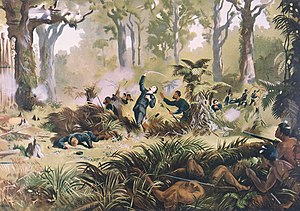Titokowaru's War
| Tītokowaru's War | |||||||
|---|---|---|---|---|---|---|---|
| Part of New Zealand wars | |||||||
 The killing of Gustavus von Tempsky by Tītokowaru's forces at Te Ngutu o Te Manu, as painted by Kennett Watkins The killing of Gustavus von Tempsky by Tītokowaru's forces at Te Ngutu o Te Manu, as painted by Kennett Watkins |
|||||||
|
|||||||
| Belligerents | |||||||
|
Ngāti Ruanui Māori tribe | ||||||
| Commanders and leaders | |||||||
| Major Thomas McDonnell Colonel George S. Whitmore Major Te Keepa Te Rangihiwinui |
Riwha Tītokowaru | ||||||
| Strength | |||||||
| 1250 | 150 to 400 | ||||||
Tītokowaru's War was a military conflict that took place in the South Taranaki region of New Zealand's North Island from June 1868 to March 1869 between the Ngāti Ruanui Māori tribe and the New Zealand Government. The conflict, near the conclusion of the New Zealand wars, was a revival of hostilities of the Second Taranaki War as Riwha Tītokowaru, chief of the Ngāti Ruanui's Ngaruahine hapu (sub-tribe), responded to the continued surveying and settlement of confiscated land with well-planned and effective attacks on settlers and government troops in an effort to block the occupation of Māori land.
The war, coinciding with a violent raid on a European settlement on the East Coast by fugitive guerrilla fighter Te Kooti, shattered what European colonists regarded as a new era of peace and prosperity, creating fears of a "general uprising of hostile Māoris", but once Tītokowaru was defeated and the East Coast threat minimised, the alienation of Māori land, as well as the political subjugation of Māori, continued at an even more rapid pace.
Tītokowaru, who had fought in the Second Taranaki War, was a most skilful West Coast Māori warrior. He also assumed the roles of a priest and prophet of the extremist Hauhau movement of the Pai Mārire religion, reviving ancient rites of cannibalism and propitiation of Māori gods with the human heart torn from the first slain in a battle. Although Tītokowaru's forces were numerically small and initially outnumbered in battle 12 to one by government troops, the ferocity of their attacks provoked fear among settlers and prompted the resignation and desertion of many militia volunteers, ultimately leading to the withdrawal of most government military forces from South Taranaki and giving Tītokowaru control of almost all the territory between New Plymouth and Wanganui.
...
Wikipedia
